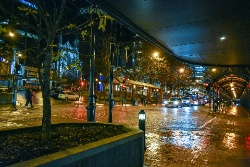Confronting Scenario To Deal With – Regional CATPlan
“It was a complex and confronting scenario to deal with, which is probably why it hasn’t been done before,” says Tairāwhiti Emergency Manager Ben Green of last week’s three-day workshop.
The workshop was to get a catastrophic plan (CATPlan) for our region 70 per cent complete, which was done.
The CATPlan covers the worst-case scenario contingency plan for our region after an M9 earthquake and tsunami.
The regional CATPlan for Te Tairāwhiti is being developed alongside the national CATPlan.
Mr Green says the inter-agency collaboration last week started our combined regional planning.
“Even getting together to run these planning events is key to the readiness of our region.”
Mr Green says one of the confronting situations they dealt with was the large loss of life after an event like this.
“There would be a considerable number of fatalities if we don’t have a focus on readiness and risk reduction.
“Who is alive and able to lead and join a response is a key consideration for every agency and needs to be covered in business continuity plans.
“This means, often first responders after a disaster of this magnitude are your whanau, meaning it would be community-led in the early stages.
“Due to this, it would make a big difference if more people in our community had some level of first aid.”
Mr Green says the plan looks at what a response operation would look like with the challenge of then managing the period immediately after an event whilst waiting for national and international support to come into the region.
“The interagency operational bits are what we do well already.
“However, the scale and magnitude of an event like this would overwhelm regional and national resources.”
The workshop was the second of three workshops being held in our region based around the M9 Hikurangi scenario.
Last year, the first workshop brought leading scientists and tsunami experts from around the world here. And in September, there’ll be a regional emergency centre simulation exercise carried out.
Key considerations of the Te Tairāwhiti CATPlan:
- It’s been estimated it takes 1 hour 40 minutes to completely evacuate the CBD and Awapuni zone, but the first wave is expected after 25 minutes,
- Critical infrastructure such as bridges will be lost or suffer major damage,
- Understanding the structural resilience of infrastructure to withstand the impacts,
- Resourcing the locations that are outside of the tsunami zones which will be supporting displaced persons,
- Do we need to invest in additional infrastructure like strengthened footbridges from the CBD to the Whataupoko area,
- The significant impact on the urban and rural coastal communities,
- Readiness activities and applying lessons learnt from previous disasters such as the Tohuku tsunami in Japan.
Upcoming events for Tairāwhiti Emergency Management include:
- Thursday 31 August - opening of the new Emergency Coordination Centre (ECC) on Potae Avenue
- Wednesday 6 – 7 September – regional simulation exercise to follow on from last week’s workshop
The Scenario
An M9 earthquake on the Hikurangi Subduction zone.
The large-scale impact of what this would look like is based on the Japan or Tohoku Magnitude 9 earthquake and tsunami in 2011, which occurred on a similar fault. The death toll from this disaster was more than 18.000 people.
This scenario envisages run-up heights along the east coast frequently in the 7m to 10m range, and in some localised places, as high as 20m.
Remember:
- A big earthquake such as an M9 centred in the Hikurangi subduction zone, off East Cape will be long and strong - so get gone.
- Tsunami could arrive soon after the earthquake - there won't be any time for an official warning.
- It's important to recognise the natural warning signs and act quickly.
- In some areas it's best to walk or bike if possible, rather than get stuck in traffic.
- If you have family inside the evacuation zone don't try to enter the zone to find them - this can cause traffic jams and slow down the safe evacuation of the area.
- Trust your children’s school to carry out their evacuation plan.
- If there's no tsunami generated after two hours (for a local event) or Civil Defence advise you sooner, it will be safe to go home.
- Listen to a local radio station for updates, and have a transistor radio with fresh batteries ready.


 Gordon Campbell: On The Hamas Ceasefire Offer, And Mark Mitchell’s Incompetence
Gordon Campbell: On The Hamas Ceasefire Offer, And Mark Mitchell’s Incompetence Wellington Office of the Mayor: Mayor Responds To Housing Minister’s District Plan Decision
Wellington Office of the Mayor: Mayor Responds To Housing Minister’s District Plan Decision Stats NZ: Have Your Say On Modernising The Census
Stats NZ: Have Your Say On Modernising The Census NZ Government: Therapeutic Products Act To Be Repealed
NZ Government: Therapeutic Products Act To Be Repealed The Treasury: Interim Financial Statements Of The Government For Nine Months Ended 31-3-2024
The Treasury: Interim Financial Statements Of The Government For Nine Months Ended 31-3-2024  Government: New Zealand Sign Language Week An Opportunity For Anyone To Sign
Government: New Zealand Sign Language Week An Opportunity For Anyone To Sign ACT New Zealand: Investment In Prisons Delivers On ACT Commitment
ACT New Zealand: Investment In Prisons Delivers On ACT Commitment


